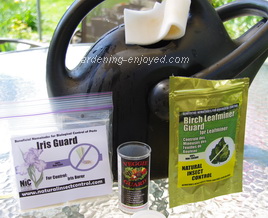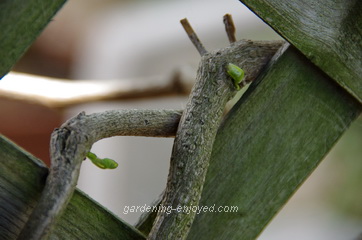
There are 35 million nematodes sitting on top of the leftover Potato Salad in the fridge. They arrived yesterday from Natural Insect Control and later today I will release them into the various areas of the garden. There are some to control the leaf miner in the Camperdown Elm, some for the vegetable garden and some to control the Iris Borer. They are a quick, easy and effective treatment for all of these problems. Each package contains a small sponge that holds 10 Million nematodes. I’ve never counted to see if the company’s count is accurate! The sponge goes into a bucket of water and we wait until the microscopic worms have left the sponge and then we dilute that stock solution into a watering can and simply water around each
susceptible plant. I admit to some skepticism the first time I used them but they worked and I have used them on more things over the years. There are still a mass of plants on the deck that have yet to be planted but the bathroom is approaching the end. Mudding the drywall this weekend and hoping to paint and lay the floor by Monday. Just because we weren’t busy enough planting, nematoding (is that a word?) and drywalling, the two adorable curly haired granddaughters, 4 & 2 years old, arrived from England yesterday, (more exciting then the nematodes arrival,) along with their parents. How do I focus on the garden when they want to Grandpa to play with them or read them stories?
 My procrastination in the garden has had some benefits. A few things that I was starting to consider as dead have finally started to show some life, having slowly recovered from the deep dormancy that our harsh winter created. Some were just deeply dormant and some have been severely reduced in size by the winter die back. The large leafed Dutchman’s Pipe vine Aristolochia durior that screened the deck from the street had been looking noticeably dead until this week. Tiny little green buds are appearing from some of the older wood and making me very happy. It has been establishing itself for several years and was a doing a very effective job. It appears that I’m left with a fair bit of pruning to remove all of the dead parts but all of the activities mentioned above will delay that job for a while, giving it ample opportunity to show me which parts are going to recover and which parts need surgery. Last year’s hardy? Fig was looking like three dead
sticks in the front garden and I had managed to get another one at the Loblaws’ media day. Yesterday there appear to be a couple of tiny green things appearing at the soil line. Another reason to leave the new one in its pot for a few more days and then I may have to find another location for it. I continued to assure the Daughter that she should wait before removing her new Rose of Sharon Hibiscus syriacus because they are always slow to emerge and her’s and mine managed to wake up this week and avoid the shovel and compost heap. Many other things are racing ahead as if winter never happened. The Fern Leaf Peony has been in bloom most of the week and yesterday, Pink Angel, the earliest of my large Peonies burst forth with a wonderful show of 15 cm (6") bright pink blooms. The mid sized Iris are blooming in several spots and my favourite tall
bearded types are throwing up many sturdy bloom stalks.
My procrastination in the garden has had some benefits. A few things that I was starting to consider as dead have finally started to show some life, having slowly recovered from the deep dormancy that our harsh winter created. Some were just deeply dormant and some have been severely reduced in size by the winter die back. The large leafed Dutchman’s Pipe vine Aristolochia durior that screened the deck from the street had been looking noticeably dead until this week. Tiny little green buds are appearing from some of the older wood and making me very happy. It has been establishing itself for several years and was a doing a very effective job. It appears that I’m left with a fair bit of pruning to remove all of the dead parts but all of the activities mentioned above will delay that job for a while, giving it ample opportunity to show me which parts are going to recover and which parts need surgery. Last year’s hardy? Fig was looking like three dead
sticks in the front garden and I had managed to get another one at the Loblaws’ media day. Yesterday there appear to be a couple of tiny green things appearing at the soil line. Another reason to leave the new one in its pot for a few more days and then I may have to find another location for it. I continued to assure the Daughter that she should wait before removing her new Rose of Sharon Hibiscus syriacus because they are always slow to emerge and her’s and mine managed to wake up this week and avoid the shovel and compost heap. Many other things are racing ahead as if winter never happened. The Fern Leaf Peony has been in bloom most of the week and yesterday, Pink Angel, the earliest of my large Peonies burst forth with a wonderful show of 15 cm (6") bright pink blooms. The mid sized Iris are blooming in several spots and my favourite tall
bearded types are throwing up many sturdy bloom stalks.
 In the vegetable garden the Tomatoes have been planted in several locations, including a few in the front gardens. The majority have been planted along with the Tomato Structure that will support the single stemmed vines all summer. We ate the first Pak Choi this week, a delightful change from the steady diet of Asparagus that we have been enjoying for almost a month now. We have even had to give some away to the neighbours. All of the Potatoes have emerged from the soil and are progressing nicely. All of the vine crops such as cucumbers and Melons
have moved from the basement to the cold frame for a few days of hardening off and they will make it into the garden some time this week. I wonder if little girls would think that planting Cucumber plants might be an exciting part of their holiday in Canada? The warm weather seeds such as Winter Squash and the Pole Beans should also find some nice warm soil to start their new life in. The Morning Glory seedlings are the perfect size for transplanting around the Pole Bean Trellis. I believe that somewhere on the deck there is a lounge chair; maybe I’ll find it by the end of the week.
In the vegetable garden the Tomatoes have been planted in several locations, including a few in the front gardens. The majority have been planted along with the Tomato Structure that will support the single stemmed vines all summer. We ate the first Pak Choi this week, a delightful change from the steady diet of Asparagus that we have been enjoying for almost a month now. We have even had to give some away to the neighbours. All of the Potatoes have emerged from the soil and are progressing nicely. All of the vine crops such as cucumbers and Melons
have moved from the basement to the cold frame for a few days of hardening off and they will make it into the garden some time this week. I wonder if little girls would think that planting Cucumber plants might be an exciting part of their holiday in Canada? The warm weather seeds such as Winter Squash and the Pole Beans should also find some nice warm soil to start their new life in. The Morning Glory seedlings are the perfect size for transplanting around the Pole Bean Trellis. I believe that somewhere on the deck there is a lounge chair; maybe I’ll find it by the end of the week.
Now it’s time to answer a few of my reader’s questions. Don’t forget to check the front page of the Website for frequent short ideas for current gardening activities.
Ann
Asks? I live near Jamestown NY (zone 5) and my ilex crenata hedge suffered foliar burn during our worse-than-usual winter this past year. Is there any hope for my bushes or are they goners? I so enjoy your newsletter.
Ken Answers! A lot of evergreens, both broad leafed and needle types have suffered this year. I would gently prune off the worst of the dead branches and wait patiently to see what happens. As you read above many things are slowly recovering.
Noel Asks? I took your course in stouffville a couple months back, thank you for the info, it has came in handy. For the tomato trellis you made on the 8ft post, when you use the nylon rope from the post to the stem, how much extra slack do you usually add for coiling the tomatoes.
Ken Answers! My ropes hang down so that there is a couple of inches touching the soil before I tie them around the plants. That leaves enough for the tying and the rope then has little
slack in it as the plants grow.
Mary Jane Asks? I have a question re hydrangeas (sorry yours died). A small worm (larva) is attacking the leaves of mine. It knits two facing leaves together along the edges like a clam shell and feeds on the small leaves emerging inside at the end of the branch. I have been manually separating the leaves and trying to squash the very small, white with black head, larva inside. (This is without my reading glasses on.) I suspect some of them fall out. The leaves are now misshapen, or stunted. What should I do to get rid of them?
Ken Answers! I have, fortunately, never encountered this creature. My research seems to indicate that what you are doing is the best approach. Manually clip off or open the leaves and step on the bug. There was some suggestion to use an insecticide spray but the larva is protected from any contact spray, such as insecticidal soap, by its pocket of Hydrangea leaves. Happy
Hydrangea harvesting.
Brenda Asks? I have a SAW TOOTH HYDRANGEA which I have had for about four years. Last year it had more leaves than normal and not as many flowers. This year most of the old branches don't have leaves at the top of them but the leaves are growing from the bottom. What should I do? HELP please!!!
Ken Answers! As you can read at the top there has been noticeable winter die back this year. Just prune the branches of your Hydrangea down to the first emerging leaves and it will come roaring back and reward you for your efforts.
111 Trent St. W.
Whitby ON
L1N1L9


 In the vegetable garden the Tomatoes have been planted in several locations, including a few in the front gardens. The majority have been planted along with the Tomato Structure that will support the single stemmed vines all summer. We ate the first Pak Choi this week, a delightful change from the steady diet of Asparagus that we have been enjoying for almost a month now. We have even had to give some away to the neighbours. All of the Potatoes have emerged from the soil and are progressing nicely. All of the vine crops such as cucumbers and Melons
have moved from the basement to the cold frame for a few days of hardening off and they will make it into the garden some time this week. I wonder if little girls would think that planting Cucumber plants might be an exciting part of their holiday in Canada? The warm weather seeds such as Winter Squash and the Pole Beans should also find some nice warm soil to start their new life in. The Morning Glory seedlings are the perfect size for transplanting around the Pole Bean Trellis. I believe that somewhere on the deck there is a lounge chair; maybe I’ll find it by the end of the week.
In the vegetable garden the Tomatoes have been planted in several locations, including a few in the front gardens. The majority have been planted along with the Tomato Structure that will support the single stemmed vines all summer. We ate the first Pak Choi this week, a delightful change from the steady diet of Asparagus that we have been enjoying for almost a month now. We have even had to give some away to the neighbours. All of the Potatoes have emerged from the soil and are progressing nicely. All of the vine crops such as cucumbers and Melons
have moved from the basement to the cold frame for a few days of hardening off and they will make it into the garden some time this week. I wonder if little girls would think that planting Cucumber plants might be an exciting part of their holiday in Canada? The warm weather seeds such as Winter Squash and the Pole Beans should also find some nice warm soil to start their new life in. The Morning Glory seedlings are the perfect size for transplanting around the Pole Bean Trellis. I believe that somewhere on the deck there is a lounge chair; maybe I’ll find it by the end of the week. My procrastination in the garden has had some benefits. A few things that I was starting to consider as dead have finally started to show some life, having slowly recovered from the deep dormancy that our harsh winter created. Some were just deeply dormant and some have been severely reduced in size by the winter die back. The large leafed Dutchman’s Pipe vine Aristolochia durior that screened the deck from the street had been looking noticeably dead until this week. Tiny little green buds are appearing from some of the older wood and making me very happy. It has been establishing itself for several years and was a doing a very effective job. It appears that I’m left with a fair bit of pruning to remove all of the dead parts but all of the activities mentioned above will delay that job for a while, giving it ample opportunity to show me which parts are going to recover and which parts need surgery. Last year’s hardy? Fig was looking like three dead
sticks in the front garden and I had managed to get another one at the Loblaws’ media day. Yesterday there appear to be a couple of tiny green things appearing at the soil line. Another reason to leave the new one in its pot for a few more days and then I may have to find another location for it. I continued to assure the Daughter that she should wait before removing her new Rose of Sharon Hibiscus syriacus because they are always slow to emerge and her’s and mine managed to wake up this week and avoid the shovel and compost heap. Many other things are racing ahead as if winter never happened. The Fern Leaf Peony has been in bloom most of the week and yesterday, Pink Angel, the earliest of my large
My procrastination in the garden has had some benefits. A few things that I was starting to consider as dead have finally started to show some life, having slowly recovered from the deep dormancy that our harsh winter created. Some were just deeply dormant and some have been severely reduced in size by the winter die back. The large leafed Dutchman’s Pipe vine Aristolochia durior that screened the deck from the street had been looking noticeably dead until this week. Tiny little green buds are appearing from some of the older wood and making me very happy. It has been establishing itself for several years and was a doing a very effective job. It appears that I’m left with a fair bit of pruning to remove all of the dead parts but all of the activities mentioned above will delay that job for a while, giving it ample opportunity to show me which parts are going to recover and which parts need surgery. Last year’s hardy? Fig was looking like three dead
sticks in the front garden and I had managed to get another one at the Loblaws’ media day. Yesterday there appear to be a couple of tiny green things appearing at the soil line. Another reason to leave the new one in its pot for a few more days and then I may have to find another location for it. I continued to assure the Daughter that she should wait before removing her new Rose of Sharon Hibiscus syriacus because they are always slow to emerge and her’s and mine managed to wake up this week and avoid the shovel and compost heap. Many other things are racing ahead as if winter never happened. The Fern Leaf Peony has been in bloom most of the week and yesterday, Pink Angel, the earliest of my large